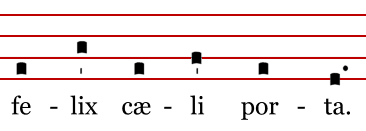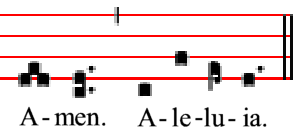There is more than one rhythmic method of singing chant. This is the Solesmes Method (the best method).
Gregorian Chant rhythm is based on groups of 2 or 3 notes or beats. A dotted note is the rhythmic equivalent of 2 notes or 2 beats.
There are definite rules for finding where the musical accent, which is called an ictus, should be. (It is not dependent on the accent of the Latin word.) These are the basic rules for finding the ictus:


In this example, the notes on the 2nd syllable of "felix" and "caeli" ("-lix" and "-li") both have an ictus.
In the example above, since the second syllable of "porta" ("-ta") has a dotted note, that is where another ictus must fall.


In this example there is a neume with more than one note on the second syllable of "Ave" and on the second syllable of "Maris", so the first note on each of those syllables ("-ve" and "-ris") has an ictus.
The second syllable of "Stella" ("-la"), also has more than one note, so the first note on that syllable also has an ictus. This neume also has a vertical episema in it, so that note of the neume also gets an ictus. The last note is dotted, so that gets an ictus too. The neume on the second syllable of "Stella" has 3 notes that are accented.
(A dotted note always counts as 2 beats. All other notes, even notes lengthened with a horizontal episema, count as 1 beat.)
Notes must always be in groups of 2 or 3: accented unaccented or accented unaccented unaccented. But there can be an unaccented beat by itself at the beginning of a line, as in the word "Ave" above.

In this example, the first note on the first syllable of "Amen" has an ictus. The other 2 notes in that neume are unaccented.
Both of the dotted notes on the second syllable are accented.
The note on the first syllable of "Alleluia" is accented.
The first note of the neume on the second syllable is accented, and the note on the last syllable is accented.

The other 2 notes on the first syllable of "Amen" must be unaccented. If the last note of that neume were given an accent, then 2 accented beats would occur together.
It cannot be the case that the note on the first syllable of "Alleluia" could be unaccented and the second note accented, because then 2 accented beats would come together.
To find where all the ictus fall where there is a series of notes and there isn't a vertical episema, a dotted note, or the first note of a neume:
go forward until you find a note that you know must be accented. Then work backwards and arrange the accents so that an unaccented beat falls immediately before the note that must have the accent, and you do not have 2 accented beats together, or more than 2 unaccented beats between accented beats.
Not all ictus are equally strong. In addition to beats, there is also a dynamic range called arsis and thesis. Phrases of Gregorian Chant either grow stronger (arsis) or softer (thesis). This is a bit more complex.
In general, where there is an ictus on the syllable where the Latin word is also accented, there is often an arsis, or increase in strength. An arsis also often occurs in a rising melody, and also at the beginning of a chant.
The most important rule for arsis and thesis is that there must always be a thesis at the end. Chant always ends with a decrease in intensity.
First page: Gregorian Chant Notation.
You can write to me at: Rick Kephart <![]() >
>
| HOME | Religion | Latin Mass | Denton | Prayer Requests | |
| Stories | Art | ******* | Commodore | Miniatures | |
| England | Italy | Florida | Musical | Gregorian Chant | LPH Resource Center |